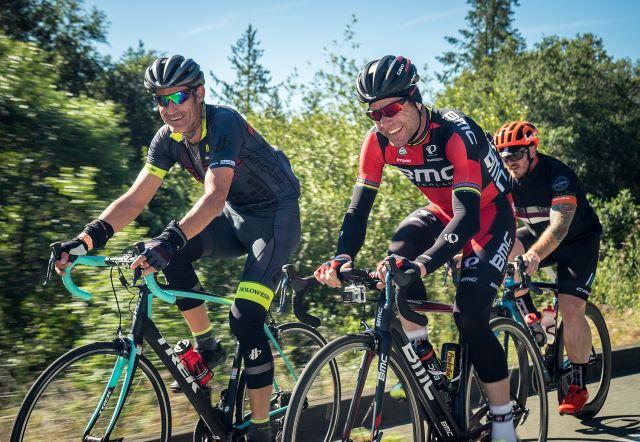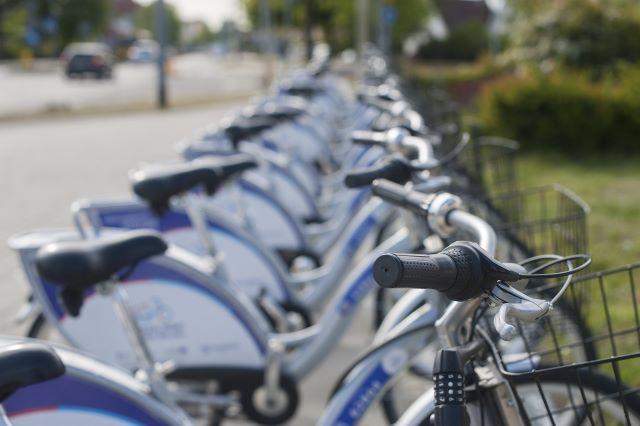Cycling is much more than just a mode of transportation; it’s a powerful way to enhance both physical and mental well-being. Whether you’re pedaling through scenic landscapes, commuting to work, or hitting the trails, cycling offers a host of health benefits that extend beyond the physical realm.

In this article, we’ll explore the multifaceted advantages of cycling, from improving cardiovascular fitness and building strength to reducing stress and boosting mental clarity. Discover how to harness the full potential of your ride and embark on a journey towards better health and vitality through the simple pleasure of cycling.
Better Physical and Mental Health through Cycling?
Cycling isn’t just a means to break a sweat; it’s a holistic activity that can transform your overall health and well-being. First and foremost, it’s an excellent cardiovascular workout, pumping oxygen-rich blood throughout your body, strengthening your heart, and enhancing your endurance.
Cycling regularly can help you shed excess weight, improve muscle tone, and boost your metabolic rate, making it a fantastic choice for those looking to maintain a healthy weight.
But the benefits extend far beyond the physical realm. Cycling is renowned for its ability to alleviate stress and reduce symptoms of anxiety and depression. The rhythmic motion of pedaling, coupled with the fresh air and immersion in nature, can have a calming and mood-lifting effect.
Moreover, cycling offers a unique opportunity for mindfulness as you focus on the present moment and the rhythm of your breath and pedal strokes.

In this article, we’ll delve into the specific advantages of cycling for your body and mind, explore tips for maximizing your cycling experience, and discuss the safety considerations to ensure that you reap the rewards while minimizing potential risks.
Whether you’re an avid cyclist or considering taking up this fulfilling activity, read on to unlock the full potential of cycling for your physical and mental health.
Physical Benefits of Cycling
Cardiovascular Fitness
When it comes to the physical benefits of cycling, one aspect that stands out is its profound impact on cardiovascular fitness. Whether you’re pedaling through scenic trails in the great outdoors or cruising along city streets, cycling gets your heart pumping and your blood flowing.

This low-impact exercise offers a fantastic way to improve your heart health, as it strengthens the muscles responsible for pumping blood, ultimately enhancing your overall cardiovascular endurance. Over time, regular cycling can help reduce your risk of heart disease, lower blood pressure, and improve cholesterol levels.
It’s an excellent way to boost your cardiovascular fitness while enjoying the beauty of nature or exploring your urban surroundings. So, if you’re looking to enhance your heart health and reap the physical benefits of cycling, it’s time to hop on that bike and start pedaling.
Weight Management
Weight management is another compelling aspect of cycling that makes it an ideal exercise for those looking to shed pounds or maintain a healthy weight. Riding a bike engages multiple muscle groups, providing an effective full-body workout. What’s even more enticing is that it’s a low-impact exercise, making it easier on your joints compared to other high-impact activities.

Whether you’re cycling at a leisurely pace or pushing yourself to conquer challenging terrains, you’re burning calories and boosting your metabolism. This not only helps you shed excess fat but also maintains a healthy body weight. Plus, cycling is a fantastic way to incorporate physical activity into your daily routine, making it easier to achieve and maintain your weight management goals.
So, if you’re aiming to shed a few pounds or simply keep your weight in check, regular cycling can be a fun and effective way to reach your fitness goals.
Low-Impact Exercise
One of the standout features of cycling as an exercise is its low-impact nature. Unlike high-impact activities such as running or intense sports, cycling is gentle on your joints and bones. This makes it an excellent choice for people of all fitness levels, including those recovering from injuries or dealing with joint issues.
When you ride a bike, the smooth, circular motion of pedaling minimizes the stress on your knees, hips, and ankles, reducing the risk of injury or discomfort.
Furthermore, low-impact exercise like cycling is a fantastic option for individuals with conditions like arthritis or osteoporosis. It allows them to engage in physical activity without exacerbating their symptoms.
This inclusivity is a big part of what makes cycling such a versatile and enjoyable exercise. So, if you’re searching for an exercise that’s kind to your body while still delivering a fantastic workout, cycling is a top choice that can help you stay active and healthy.
Cycling can have many Mental Benefits too
Stress Relief
Cycling not only benefits your physical health but also offers valuable mental advantages, including stress relief. The rhythmic pedaling, exposure to nature, and release of endorphins during a ride can significantly reduce stress and enhance your mood.
Additionally, cycling can be a social activity, providing an opportunity for interaction and relaxation with fellow cyclists. In summary, cycling is a simple yet effective way to clear your mind, boost your mental well-being, and find peace while enjoying the ride.
Reduce Anxiety
Cycling is a powerful ally in reducing anxiety. The rhythmic pedaling, exposure to nature, and release of endorphins can effectively alleviate anxiety levels. Moreover, the social aspect of cycling can provide additional emotional support and relaxation. In essence, cycling offers a natural and enjoyable way to reduce anxiety and promote mental well-being.

Brain Health
Cycling also offers notable benefits for brain health. The physical activity involved in cycling promotes better blood circulation to the brain, which can enhance cognitive function and memory. Additionally, the stress-reducing effects of cycling can contribute to improved mental clarity and overall brain health.
In essence, cycling is a holistic activity that supports both physical and mental well-being, including the health of your brain.
Tips for the Best Cycling Experience
Proper Bike Fit and Equipment
1. Choosing the right bike size and adjustments
Proper bike fit and equipment are crucial for an enjoyable and safe cycling experience. First and foremost, choosing the right bike size and making necessary adjustments is paramount. The bike should fit your body size and shape comfortably. Ensure the saddle height, handlebar position, and pedal alignment are adjusted to suit your body’s ergonomics.
A well-fitted bike not only reduces the risk of discomfort and injury but also maximizes your efficiency and control while cycling. It’s the foundation for a great riding experience, and getting it right from the start is essential.
2. Essential gear and safety equipment
When it comes to cycling, having the right gear and safety equipment is essential for both your enjoyment and well-being. Firstly, invest in a quality helmet that fits snugly and provides adequate protection for your head. Helmets are non-negotiable for safety.
Additionally, consider wearing padded cycling shorts for added comfort during long rides, and don’t forget gloves to protect your hands and improve grip.

Visibility is crucial, especially when cycling on roads, so equip your bike with front and rear lights. A good set of lights ensures you’re seen by other road users, enhancing your safety. Reflective clothing or accessories can also boost visibility.
Lastly, maintain your bike regularly. Check the tires, brakes, and gears to ensure they’re in optimal condition. Carrying basic tools like a tire pump, spare tube, and multi-tool is wise, as it can save you from being stranded in case of a breakdown.
In summary, investing in essential gear and safety equipment is a small but vital step to ensure a safe and enjoyable cycling experience. Your gear not only keeps you protected but also enhances your overall comfort and confidence while out on the road or trail.
Planning and Variation
1. Setting goals and creating a cycling routine
Planning and variation are keys to a rewarding cycling experience. Start by setting clear goals and creating a cycling routine that aligns with your objectives. Whether it’s improving your fitness, tackling longer distances, or exploring new trails, having goals provides motivation and direction. Your routine should include regular rides that progressively challenge you while allowing for adequate rest.

Additionally, vary your rides to keep things interesting. Explore different routes, terrains, and cycling styles. This not only prevents monotony but also works for different muscle groups, improving your overall fitness. Planning and variation are essential elements that keep your cycling journey engaging, purposeful, and full of growth.
2. Exploring different routes and terrains for a diverse experience
Exploring different routes and terrains is a cornerstone of a diverse and exciting cycling experience. Instead of sticking to the same old paths, venture out to discover new routes, whether they lead you through picturesque countryside, urban landscapes, or challenging mountain trails. By doing so, you not only add excitement to your rides but also improve your cycling skills and adaptability.

Different terrains offer unique challenges and benefits. For instance, off-road trails can enhance your balance and agility, while hilly routes provide an excellent opportunity to build strength and endurance. Mixing up your cycling terrain keeps things fresh and prevents burnout, ensuring that every ride is an adventure. So, don’t hesitate to explore new paths and terrains to elevate your cycling journey.
Nutrition and Hydration
1. Fuelling your body with proper nutrition before and after rides
Nutrition and hydration play a vital role in optimizing your cycling performance. To make the most of your rides, it’s essential to fuel your body with proper nutrition before and after cycling sessions.
Before hopping on your bike, ensure you’ve had a balanced meal containing carbohydrates, proteins, and healthy fats. Carbs provide readily available energy, while proteins aid in muscle repair and recovery. Also, don’t forget to stay hydrated. Proper hydration is critical for maintaining stamina and preventing fatigue.

Post-ride nutrition is equally crucial. Refuel your body with a combination of carbs and protein within the first hour after your ride. This aids in muscle recovery and glycogen replenishment. Hydration should continue, as cycling can lead to significant fluid loss through sweat.
In summary, giving your body the right nutrients and staying properly hydrated before and after cycling not only boosts your performance but also supports muscle recovery, helping you get the most out of your rides.
2. Staying hydrated during cycling sessions
Staying adequately hydrated during cycling sessions is paramount to maintain your performance and ensure safety. Dehydration can lead to reduced endurance, muscle cramps, and even heat-related illnesses. Therefore, make it a priority to drink fluids throughout your ride.
Carry a water bottle or a hydration pack, and take sips regularly, especially on warm or long rides. Pay attention to your body’s signals; if you feel thirsty, it’s an indicator that you need to drink more. Electrolyte-enhanced drinks can also be beneficial, as they help replace essential minerals lost through sweating.
Remember that staying hydrated is not just about preventing discomfort; it’s a key element in optimizing your cycling experience. Proper hydration keeps your energy levels stable, allows your muscles to function efficiently, and ensures you can enjoy your ride to the fullest.
Safety Precautions and Injury Prevention
Bike Maintenance
1. Regular checks and maintenance of your bike
Regularly checking and maintaining your bike is essential for its longevity and safety. Start by inspecting your bike before every ride. Check tire pressure to ensure they’re properly inflated, inspect the brakes for responsiveness, and make sure gears shift smoothly.
Perform routine cleaning to remove dirt and grime that can wear down components. Lubricate the chain and other moving parts to prevent friction and ensure a smooth ride. Keep an eye on the condition of your tires and replace them when the tread wears down.

Additionally, schedule periodic maintenance with a professional bike mechanic. They can perform more in-depth checks and adjustments, ensuring your bike is in optimal working condition. By prioritizing bike maintenance, you not only prolong your bike’s life but also guarantee a safer and more enjoyable cycling experience.
2. Ensuring proper tire pressure, brakes, and gears
Ensuring proper tire pressure, brakes, and gears is fundamental for a safe and enjoyable cycling experience.
Start with your tires. Maintain the correct tire pressure as recommended by the manufacturer. Properly inflated tires provide better traction, reduce rolling resistance, and enhance your bike’s handling.
Next, focus on your brakes. Ensure they are in good working order, with brake pads that have sufficient life left. Test your brakes regularly to confirm they respond promptly and effectively.

Lastly, pay attention to your bike’s gears. Make sure they shift smoothly and accurately. Lubricate cables and derailleurs as needed, and adjust the tension to prevent chain slipping or misalignment.
By regularly checking and maintaining these critical components, you not only ensure your safety on the road but also guarantee a smooth and trouble-free ride, allowing you to get the most out of your cycling adventures.
Traffic Rules and Road Awareness
1. Obeying traffic laws and signals
Obeying traffic laws and signals is a non-negotiable aspect of safe cycling, especially when sharing the road with other vehicles. Treat your bike as you would any other vehicle and adhere to all traffic regulations.
This means stopping at stop signs and red lights, yielding the right of way when necessary, and using hand signals to indicate turns. Stay in designated bike lanes where available and ride in the same direction as traffic. Additionally, make yourself visible to motorists by using lights and reflectors, especially when riding at dawn, dusk, or in low-light conditions.

By obeying traffic laws and signals, you not only ensure your own safety but also contribute to a harmonious and safe environment for all road users. It’s a fundamental responsibility that every cyclist should uphold to enjoy a secure and respectful riding experience.
2. Practicing defensive cycling and situational awareness
Practicing defensive cycling and situational awareness is crucial when sharing the road with other vehicles. Be vigilant and anticipate potential hazards by staying aware of your surroundings. Keep an eye on traffic and stay visible to drivers.
Maintain a safe distance from parked cars to avoid suddenly opening doors. Always assume that drivers may not see you, so make eye contact when possible and use hand signals to indicate your intentions.

Furthermore, avoid distractions such as using your phone or wearing headphones while riding. Focus on the road and be prepared to react quickly to changing situations.
By practicing defensive cycling and maintaining situational awareness, you can significantly reduce the risk of accidents and ensure a safe and pleasant cycling experience on the road. Your safety and the safety of others depend on it.
Conclusion
In conclusion, cycling offers a wealth of physical and mental benefits, making it a fantastic choice for those seeking a healthier and more fulfilling lifestyle. From cardiovascular fitness and weight management to stress relief and improved brain health, the advantages of cycling are numerous and undeniable.
To fully embrace these benefits, it’s essential to pay attention to key factors like proper bike fit and equipment, goal setting, route variation, nutrition, hydration, bike maintenance, and road safety. By prioritizing these aspects and adopting a holistic approach to cycling, you can maximize your enjoyment, safety, and overall well-being on every ride.
So, whether you’re a seasoned cyclist or just starting your journey, remember that cycling is not just a means of transportation; it’s a path to better physical and mental health. Embrace it, explore new horizons, and pedal your way to a happier and healthier life.
FAQs:
Can cycling help with weight loss?
Absolutely! Cycling is an excellent activity for weight loss. It’s a low-impact exercise that burns calories and promotes fat loss. To achieve weight loss through cycling, it’s essential to maintain a consistent routine and pay attention to your diet. Combining regular rides with a balanced diet can help you shed excess pounds and improve your overall fitness.
What type of bike is best for beginners?
For beginners, a versatile and comfortable bike like a hybrid or a fitness bike is an excellent choice. These bikes offer a balanced mix of features from road and mountain bikes, making them suitable for various terrains. They provide a comfortable riding position and stable handling, making them ideal for those new to cycling. As you gain experience and define your preferences, you can explore more specialized options.
How often should I cycle to see health benefits?
To reap the health benefits of cycling, aim for at least 150 minutes of moderate-intensity cycling or 75 minutes of vigorous-intensity cycling per week, as recommended by health guidelines. This translates to around 30 minutes of cycling on most days. However, the frequency and duration of your rides can vary based on your fitness goals. The key is to find a routine that you can sustain and enjoy over the long term.
Are there any age restrictions for cycling?
There are no specific age restrictions for cycling. Cycling is a low-impact exercise that can be enjoyed by people of all ages. However, it’s essential to consider your own physical capabilities and any potential medical conditions. If you have any concerns about your ability to cycle safely, it’s advisable to consult with a healthcare professional or a certified cycling coach. With proper precautions and adjustments, people of all ages can experience the many benefits of cycling.
Can cycling be beneficial for people with joint problems?
Absolutely, cycling is often recommended for people with joint problems. It’s a low-impact exercise that’s gentle on the joints, making it an excellent choice for those dealing with conditions like arthritis or knee issues. Cycling allows you to engage in physical activity without subjecting your joints to the same level of stress as high-impact activities like running or jumping.
However, it’s crucial to ensure your bike is properly fitted to your body to minimize the risk of exacerbating joint discomfort. If you have specific joint concerns, it’s advisable to consult with a healthcare professional or a physical therapist to determine the most suitable approach to cycling for your individual needs.









